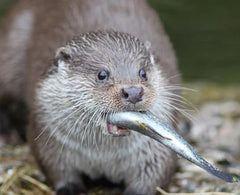You have no items in your shopping cart.
- Electric Netting
- Tape, Twine, Wire And Rope
- Fencing Energisers
- Fencing Posts
- Insulators
- Accessories
- Electric Fencing Kits
- Chicken Feeders and Drinkers
-
Information
- What is Electric Fencing
- Advantages of an Electric Fence
- Installing a Fence
- Is an Electric Fence a serious risk
- How to Erect a Net
- What you Need for a Fence
- Testing an Electric Fence
- Quantities Guide
- Improve Your Fence
- Poultry Netting Trial
- Electric Netting Dimensions
- Electric Fencing Mistakes
- TLD Max Technology
- Energiser Terminology
- Choosing an Energiser
- Fencing Articles
- Trouble Shooting
- Delivery Terms
- Frequently Asked Questions
- Here's a Blog Worth Reading
Otters and Electric Fencing
Otters, which were common up until the sixties had largely disappeared by the early eighties as a result of both persecution and, more significantly, their exposure to pesticides accumulated in fish. In 1978 otters were given full legal protection.
Under this protection otters showed some small recovery. In the nineties the UK Biodiversity Action Plan for Otters was launched. With the help of government  funding, numerous agencies began to actively encourage an increase in the otter population. This included the restoration of habitat, the creation of artificial holts and measures to ensure that civil engineering and development such as road building and flood defence included provisions to protect and encourage otters. Releases of otters into the wild were also carried out. Releases have now largely finished but it is still permitted to release captive bred or captive reared otters into the wild.
funding, numerous agencies began to actively encourage an increase in the otter population. This included the restoration of habitat, the creation of artificial holts and measures to ensure that civil engineering and development such as road building and flood defence included provisions to protect and encourage otters. Releases of otters into the wild were also carried out. Releases have now largely finished but it is still permitted to release captive bred or captive reared otters into the wild.
As a result of these measures the otter population in is now well established and growing – with potentially devastating consequences for many fisheries. Major problems have already occurred in parts of the country with angling clubs helpless to prevent prime fisheries being destroyed and suffering financial losses running into many thousands of pounds. Otters are now being recorded across the country having serious effects on fish stocks.
In an effort to reduce the effect of otters and to exclude them from private fisheries, total exclusion fences have been constructed utilising a combination of traditional weld mesh fencing and electric fencing has been erected around Cleabarrow and Atkinsons fisheries. The electric fence has been added to the weld mesh as outriggers set 75mm off the fence at 150mm high (ie; nose height of a standing otter). This was dispensed with where the fence ran into the water. Two further higher wires were attached mid way up the mesh fence. These based on the nose height of an otter standing on its’ hind legs to inspect the fence. It is important that the fence wires have a high voltage, nothing less than 6000v running through them. It is suggested that the weld mesh is further connected to the earth posts so creating an “Earth Return” fence and so increasing its effectiveness.
The efficacy of this fence has now been monitored over 18 months and adjustments are necessary where it was not possible to install Electric wiring as this was seen to be still vulnerable to incursion. The aquatic habitat of the otter makes it difficult to utilise Electric Fencing within flooded stream beds that create the access routes of otters.








← Older Post Newer Post →
0 comments